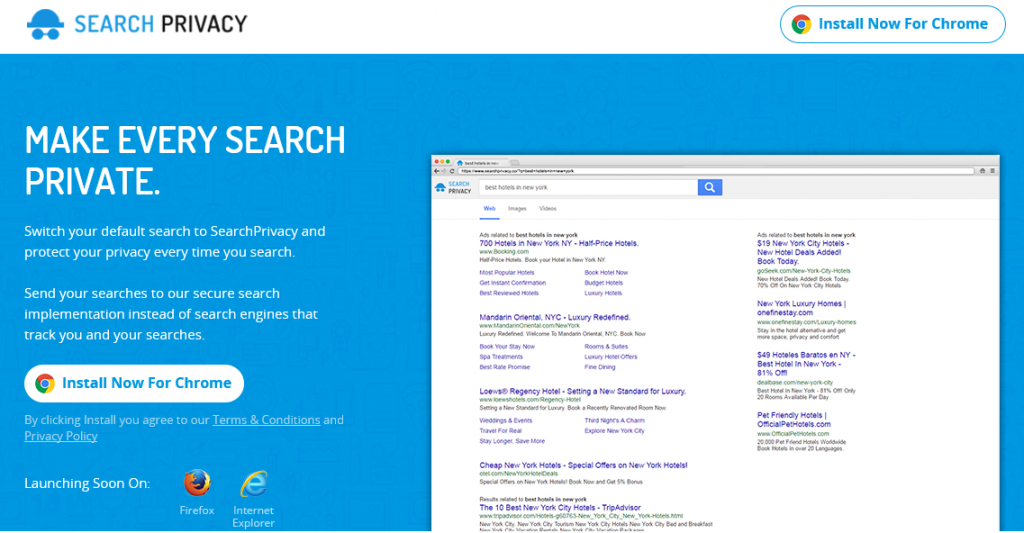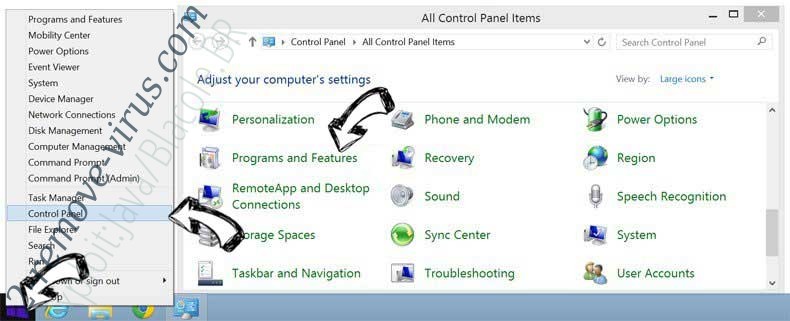What is Search-Privacy.net?
Search-Privacy.net is a dubious browser extension and a browser hijacker. It’s not a malicious computer virus, although specialists refer to it as a redirect virus. It is known as that because it redirects users to sponsored websites in order to generate pay-per-click revenue for those sites. It’s not going to harm your computer, though it will get on your nerves. Usually the redirects are harmless but in some cases you could be redirected to a dangerous website and unknowingly end up with malware. We suggest you think twice about keeping this browser hijacker, and delete Search-Privacy.net.

Why should I uninstall Search-Privacy.net?
Search-Privacy.net has an official website where you can download this extension but if you do not remember doing that, it has entered your computer via software bundles. It was attached to freeware as an optional item. This is not unusual as freeware can have many different items attached to it. Such as browser hijackers, adware and other potentially unwanted programs. If you use Default settings, those items will install automatically, without your knowledge. To avoid unwanted installations, you need to use Advanced or Custom settings. Only in those settings will you be able to view and deselect added items.
Search-Privacy.net is advertised as a browser add-on that can help you remain private when you use the Internet. It promises to keep you safe. It claims to not track your searches and yet in the Privacy Policy it says it will collect information related to what you search for. In any case, it can hijack your Internet Explorer and Mozilla Firefox browsers and alter their settings. Your homepage, new tabs and search engine will be changed to searchprivacy.co and you might not be able to restore the settings unless you first remove Search-Privacy.net from your computer. The search engine will insert sponsored websites and ads into the search results, and you will end up on websites that have nothing to do with what you were searching for. This can be incredibly frustrating when you are looking for something important and have to go through countless useless results. It could even lead to a virus infection. You could be redirected to an infected domain and end up downloading malware. Uninstall Search-Privacy.net to return to normal browsing.
Search-Privacy.net removal
Whether you downloaded Search-Privacy.net yourself or it infected your computer via freeware, we strongly recommend you delete Search-Privacy.net. If you choose to do so, you have two options. You can remove Search-Privacy.net manually but you will need to locate and erase Search-Privacy.net related applications yourself. If you do not feel confident with doing that, allow anti-malware software to take care of Search-Privacy.net removal for you.
Offers
Download Removal Toolto scan for Search-Privacy.netUse our recommended removal tool to scan for Search-Privacy.net. Trial version of provides detection of computer threats like Search-Privacy.net and assists in its removal for FREE. You can delete detected registry entries, files and processes yourself or purchase a full version.
More information about SpyWarrior and Uninstall Instructions. Please review SpyWarrior EULA and Privacy Policy. SpyWarrior scanner is free. If it detects a malware, purchase its full version to remove it.
WiperSoft Review Details WiperSoft (www.wipersoft.com) is a security tool that provides real-time security from potential threats. Nowadays, many users tend to download free software from the Intern ...
Download|moreIs MacKeeper a virus? MacKeeper is not a virus, nor is it a scam. While there are various opinions about the program on the Internet, a lot of the people who so notoriously hate the program have neve ...
Download|moreWhile the creators of MalwareBytes anti-malware have not been in this business for long time, they make up for it with their enthusiastic approach. Statistic from such websites like CNET shows that th ...
Download|more
Quick Menu
Step 1. Uninstall Search-Privacy.net and related programs.
Remove Search-Privacy.net from Windows 8
Right-click in the lower left corner of the screen. Once Quick Access Menu shows up, select Control Panel choose Programs and Features and select to Uninstall a software.

Uninstall Search-Privacy.net from Windows 7
Click Start → Control Panel → Programs and Features → Uninstall a program.
Delete Search-Privacy.net from Windows XP
Click Start → Settings → Control Panel. Locate and click → Add or Remove Programs.
Remove Search-Privacy.net from Mac OS X
Click Go button at the top left of the screen and select Applications. Select applications folder and look for Search-Privacy.net or any other suspicious software. Now right click on every of such entries and select Move to Trash, then right click the Trash icon and select Empty Trash.
Step 2. Delete Search-Privacy.net from your browsers
Terminate the unwanted extensions from Internet Explorer
- Tap the Gear icon and go to Manage Add-ons.
- Pick Toolbars and Extensions and eliminate all suspicious entries (other than Microsoft, Yahoo, Google, Oracle or Adobe)
- Leave the window.
Change Internet Explorer homepage if it was changed by virus:
- Tap the gear icon (menu) on the top right corner of your browser and click Internet Options.
- In General Tab remove malicious URL and enter preferable domain name. Press Apply to save changes.
Reset your browser
- Click the Gear icon and move to Internet Options.
- Open the Advanced tab and press Reset.
- Choose Delete personal settings and pick Reset one more time.
- Tap Close and leave your browser.
- If you were unable to reset your browsers, employ a reputable anti-malware and scan your entire computer with it.
Erase Search-Privacy.net from Google Chrome
- Access menu (top right corner of the window) and pick Settings.
- Choose Extensions.
- Eliminate the suspicious extensions from the list by clicking the Trash bin next to them.
- If you are unsure which extensions to remove, you can disable them temporarily.
Reset Google Chrome homepage and default search engine if it was hijacker by virus
- Press on menu icon and click Settings.
- Look for the “Open a specific page” or “Set Pages” under “On start up” option and click on Set pages.
- In another window remove malicious search sites and enter the one that you want to use as your homepage.
- Under the Search section choose Manage Search engines. When in Search Engines..., remove malicious search websites. You should leave only Google or your preferred search name.
Reset your browser
- If the browser still does not work the way you prefer, you can reset its settings.
- Open menu and navigate to Settings.
- Press Reset button at the end of the page.
- Tap Reset button one more time in the confirmation box.
- If you cannot reset the settings, purchase a legitimate anti-malware and scan your PC.
Remove Search-Privacy.net from Mozilla Firefox
- In the top right corner of the screen, press menu and choose Add-ons (or tap Ctrl+Shift+A simultaneously).
- Move to Extensions and Add-ons list and uninstall all suspicious and unknown entries.
Change Mozilla Firefox homepage if it was changed by virus:
- Tap on the menu (top right corner), choose Options.
- On General tab delete malicious URL and enter preferable website or click Restore to default.
- Press OK to save these changes.
Reset your browser
- Open the menu and tap Help button.
- Select Troubleshooting Information.
- Press Refresh Firefox.
- In the confirmation box, click Refresh Firefox once more.
- If you are unable to reset Mozilla Firefox, scan your entire computer with a trustworthy anti-malware.
Uninstall Search-Privacy.net from Safari (Mac OS X)
- Access the menu.
- Pick Preferences.
- Go to the Extensions Tab.
- Tap the Uninstall button next to the undesirable Search-Privacy.net and get rid of all the other unknown entries as well. If you are unsure whether the extension is reliable or not, simply uncheck the Enable box in order to disable it temporarily.
- Restart Safari.
Reset your browser
- Tap the menu icon and choose Reset Safari.
- Pick the options which you want to reset (often all of them are preselected) and press Reset.
- If you cannot reset the browser, scan your whole PC with an authentic malware removal software.
Site Disclaimer
2-remove-virus.com is not sponsored, owned, affiliated, or linked to malware developers or distributors that are referenced in this article. The article does not promote or endorse any type of malware. We aim at providing useful information that will help computer users to detect and eliminate the unwanted malicious programs from their computers. This can be done manually by following the instructions presented in the article or automatically by implementing the suggested anti-malware tools.
The article is only meant to be used for educational purposes. If you follow the instructions given in the article, you agree to be contracted by the disclaimer. We do not guarantee that the artcile will present you with a solution that removes the malign threats completely. Malware changes constantly, which is why, in some cases, it may be difficult to clean the computer fully by using only the manual removal instructions.